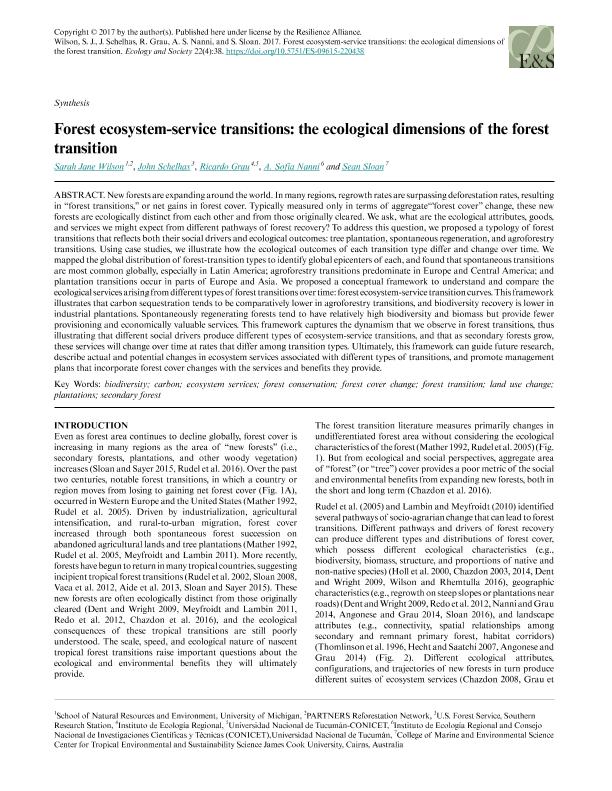Mostrar el registro sencillo del ítem
dc.contributor.author
Wilson, Sarah Jane
dc.contributor.author
Schelhas, John
dc.contributor.author
Grau, Hector Ricardo

dc.contributor.author
Nanni, Ana Sofía

dc.contributor.author
Sloan, Sean
dc.date.available
2019-01-04T19:55:33Z
dc.date.issued
2017-12
dc.identifier.citation
Wilson, Sarah Jane; Schelhas, John; Grau, Hector Ricardo; Nanni, Ana Sofía; Sloan, Sean; Forest ecosystem-service transitions: the ecological dimensions of the forest transition; Resilience Alliance; Ecology and Society; 22; 4; 12-2017; 38
dc.identifier.issn
1708-3087
dc.identifier.uri
http://hdl.handle.net/11336/67453
dc.description.abstract
New forests are expanding around the world. In many regions, regrowth rates are surpassing deforestation rates, resulting in “forest transitions,” or net gains in forest cover. Typically measured only in terms of aggregate“’forest cover” change, these new forests are ecologically distinct from each other and from those originally cleared. We ask, what are the ecological attributes, goods, and services we might expect from different pathways of forest recovery? To address this question, we proposed a typology of forest transitions that reflects both their social drivers and ecological outcomes: tree plantation, spontaneous regeneration, and agroforestry transitions. Using case studies, we illustrate how the ecological outcomes of each transition type differ and change over time. We mapped the global distribution of forest-transition types to identify global epicenters of each, and found that spontaneous transitions are most common globally, especially in Latin America; agroforestry transitions predominate in Europe and Central America; and plantation transitions occur in parts of Europe and Asia. We proposed a conceptual framework to understand and compare the ecological services arising from different types of forest transitions over time: forest ecosystem-service transition curves. This framework illustrates that carbon sequestration tends to be comparatively lower in agroforestry transitions, and biodiversity recovery is lower in industrial plantations. Spontaneously regenerating forests tend to have relatively high biodiversity and biomass but provide fewer provisioning and economically valuable services. This framework captures the dynamism that we observe in forest transitions, thus illustrating that different social drivers produce different types of ecosystem-service transitions, and that as secondary forests grow, these services will change over time at rates that differ among transition types. Ultimately, this framework can guide future research, describe actual and potential changes in ecosystem services associated with different types of transitions, and promote management plans that incorporate forest cover changes with the services and benefits they provide.
dc.format
application/pdf
dc.language.iso
eng
dc.publisher
Resilience Alliance

dc.rights
info:eu-repo/semantics/openAccess
dc.rights.uri
https://creativecommons.org/licenses/by-nc/2.5/ar/
dc.subject
Biodiversity
dc.subject
Carbon
dc.subject
Ecosystem Services
dc.subject
Forest Conservation
dc.subject
Forest Cover Change
dc.subject
Forest Transition
dc.subject
Land Use Change
dc.subject
Plantations
dc.subject
Secondary Forest
dc.subject.classification
Otras Ciencias Biológicas

dc.subject.classification
Ciencias Biológicas

dc.subject.classification
CIENCIAS NATURALES Y EXACTAS

dc.title
Forest ecosystem-service transitions: the ecological dimensions of the forest transition
dc.type
info:eu-repo/semantics/article
dc.type
info:ar-repo/semantics/artículo
dc.type
info:eu-repo/semantics/publishedVersion
dc.date.updated
2018-10-23T20:39:17Z
dc.journal.volume
22
dc.journal.number
4
dc.journal.pagination
38
dc.journal.pais
Canadá

dc.journal.ciudad
Nova Scotia
dc.description.fil
Fil: Wilson, Sarah Jane. University of Michigan; Estados Unidos. Partners Reforestation Network; Estados Unidos
dc.description.fil
Fil: Schelhas, John. United States Forest Service, Southern Research Station; Estados Unidos
dc.description.fil
Fil: Grau, Hector Ricardo. Universidad Nacional de Tucumán. Instituto de Ecología Regional. Consejo Nacional de Investigaciones Científicas y Técnicas. Centro Científico Tecnológico Conicet - Tucumán. Instituto de Ecología Regional; Argentina
dc.description.fil
Fil: Nanni, Ana Sofía. Universidad Nacional de Tucumán. Instituto de Ecología Regional. Consejo Nacional de Investigaciones Científicas y Técnicas. Centro Científico Tecnológico Conicet - Tucumán. Instituto de Ecología Regional; Argentina
dc.description.fil
Fil: Sloan, Sean. James Cook University; Australia
dc.journal.title
Ecology and Society

dc.relation.alternativeid
info:eu-repo/semantics/altIdentifier/url/https://www.ecologyandsociety.org/vol22/iss4/art38/
dc.relation.alternativeid
info:eu-repo/semantics/altIdentifier/doi/http://dx.doi.org/10.5751/ES-09615-220438
Archivos asociados
